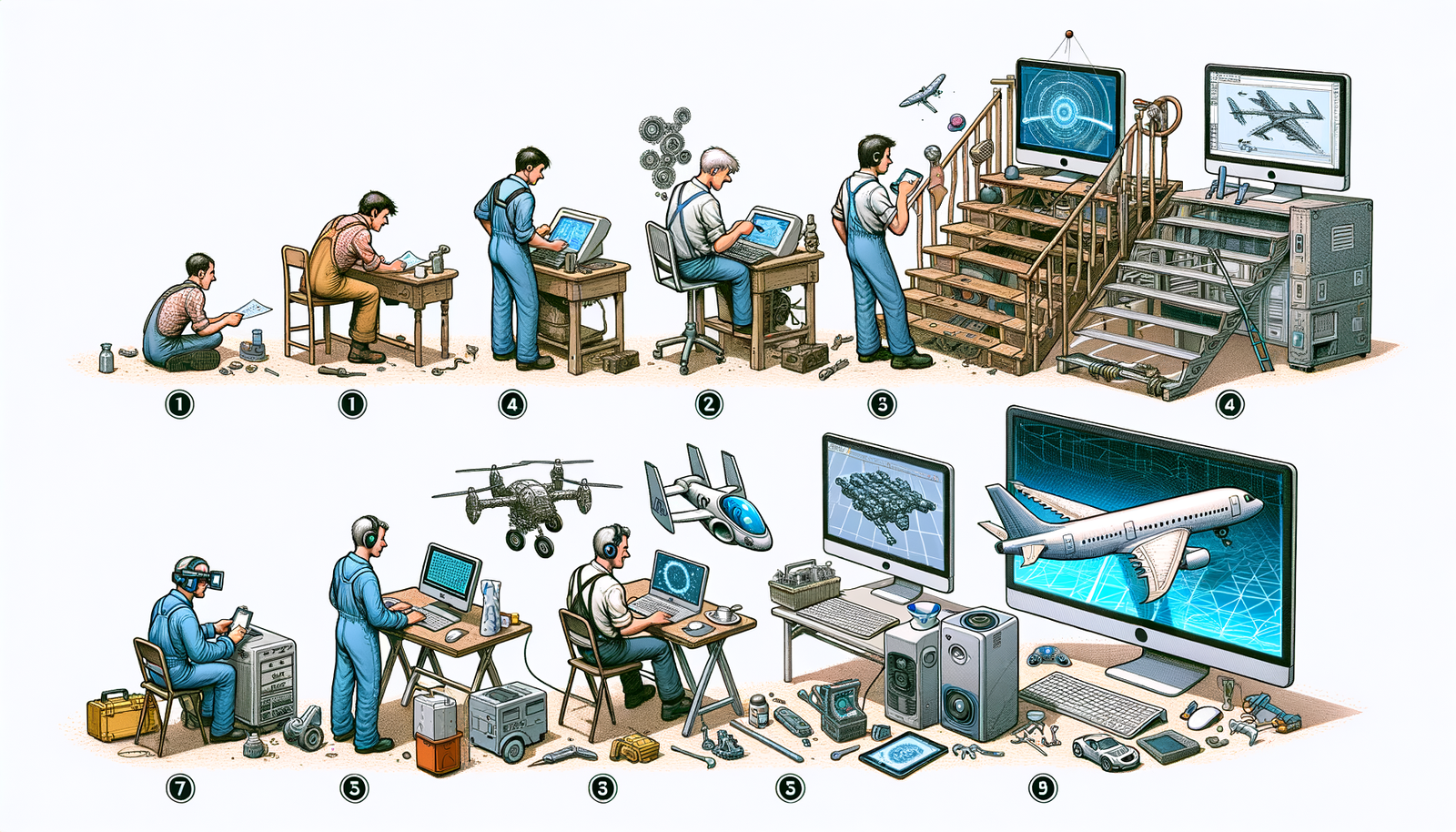Your Cart is Empty
Customer Testimonials
-
"Great customer service. The folks at Novedge were super helpful in navigating a somewhat complicated order including software upgrades and serial numbers in various stages of inactivity. They were friendly and helpful throughout the process.."
Ruben Ruckmark
"Quick & very helpful. We have been using Novedge for years and are very happy with their quick service when we need to make a purchase and excellent support resolving any issues."
Will Woodson
"Scott is the best. He reminds me about subscriptions dates, guides me in the correct direction for updates. He always responds promptly to me. He is literally the reason I continue to work with Novedge and will do so in the future."
Edward Mchugh
"Calvin Lok is “the man”. After my purchase of Sketchup 2021, he called me and provided step-by-step instructions to ease me through difficulties I was having with the setup of my new software."
Mike Borzage
Design Software History: Evolution of CAD Technologies in Aerospace Maintenance: From Early Adoption to Future Innovations
May 25, 2024 4 min read


Introduction to the Aerospace Maintenance Sector and CAD
The aerospace maintenance sector plays a crucial role in ensuring the safety, reliability, and efficiency of aircraft. Maintenance activities include routine checks, repairs, and overhauls, which are essential to keep aircraft operational and compliant with regulatory standards. The sector faces significant challenges, such as adhering to strict safety protocols, managing vast amounts of technical information, and increasing operational efficiency to minimize aircraft downtime.
Computer-Aided Design (CAD) is a technology that has revolutionized various industries, including aerospace. CAD systems enable the creation, modification, analysis, and optimization of a design digitally. The early development of CAD dates back to the 1960s when it was primarily used for automating drafting tasks. Over the decades, CAD has evolved into a sophisticated tool that supports complex modeling and simulation tasks. In the aerospace industry, CAD plays a pivotal role in designing aircraft components, as well as in maintaining and repairing them, thus enhancing the overall efficiency and safety of maintenance operations.
Historical Development of CAD in Aerospace Maintenance
The early adoption of CAD technologies in the aerospace maintenance sector marked a significant shift from manual drafting to digital design methods. In the 1980s, companies began to explore the potential of CAD for maintenance purposes. Early adopters realized that CAD could streamline maintenance processes, reduce errors, and improve the accuracy of maintenance documentation.
One of the key milestones in the integration of CAD for maintenance purposes was the development of digital mock-ups (DMUs), which allowed maintenance engineers to visualize and interact with aircraft components in a virtual environment. This capability greatly enhanced the ability to plan and execute maintenance tasks with higher precision.
Major aerospace companies such as Boeing and Airbus were at the forefront of adopting and advancing CAD technologies. Boeing's use of CAD for the design and maintenance of the 777 aircraft set a new standard in the industry. Airbus also made significant contributions by integrating CAD into their maintenance workflows, leading to improved efficiency and safety in their operations.
Notable individuals have played critical roles in advancing CAD technologies. John Walker, the founder of Autodesk, was instrumental in developing AutoCAD, one of the most widely used CAD software tools. His contributions laid the foundation for the widespread adoption of CAD across various industries, including aerospace.
Evolution of CAD Software and Technologies in Aerospace Maintenance
The evolution of CAD software in aerospace maintenance has been marked by significant advancements in solid modeling and parametric design. Initially, CAD systems were primarily used for 2D drafting. However, the transition to 3D modeling brought about a revolution in the way maintenance tasks were planned and executed.
**Solid modeling** techniques enabled maintenance engineers to create detailed and accurate representations of aircraft components. This capability allowed for better visualization and analysis of complex parts, leading to more effective maintenance procedures. The adoption of **parametric design** principles further enhanced the capabilities of CAD systems by allowing engineers to create models that could be easily modified based on changing requirements.
Advanced technologies such as finite element analysis (FEA) and computational fluid dynamics (CFD) have also been integrated into CAD systems. FEA is used to predict the structural behavior of components under various loads, enabling maintenance engineers to identify potential issues before they lead to failures. CFD, on the other hand, helps in analyzing the aerodynamic properties of components, which is crucial for maintaining optimal performance.
Non-Uniform Rational B-Splines (NURBS) have been employed for high-precision modeling of complex aerospace components. NURBS provide the flexibility to create smooth and accurate curves and surfaces, which are essential for designing and maintaining intricate parts of an aircraft.
Modern Applications and Future Trends
The current state of CAD in aerospace maintenance is characterized by the use of advanced software tools that provide comprehensive solutions for design, analysis, and maintenance. Leading CAD software tools in the aerospace sector include CATIA by Dassault Systèmes and Siemens NX. These tools offer a wide range of functionalities that address the specific needs of aerospace maintenance, such as digital mock-ups, simulation, and documentation.
Modern CAD tools are equipped with features that help in overcoming current challenges in aerospace maintenance. For instance, they enable the creation of detailed maintenance manuals, support the simulation of maintenance procedures, and facilitate collaboration among maintenance teams. These capabilities contribute to improving the efficiency and accuracy of maintenance tasks, ultimately enhancing the safety and reliability of aircraft operations.
Looking into the future, emerging technologies such as artificial intelligence (AI) and machine learning (ML) are poised to revolutionize predictive maintenance in the aerospace sector. AI and ML algorithms can analyze vast amounts of data from aircraft sensors to predict potential maintenance issues before they occur. This proactive approach can reduce downtime and maintenance costs while ensuring the highest levels of safety.
**Digital twins** are another emerging technology with significant potential in aerospace maintenance. A digital twin is a virtual replica of a physical asset, such as an aircraft or its components. By simulating real-world conditions, digital twins enable maintenance engineers to monitor the condition of an aircraft in real-time and predict its future performance. This technology can lead to more informed maintenance decisions and optimized maintenance schedules.
**Augmented reality (AR)** is also expected to have a profound impact on future maintenance practices. AR can provide maintenance technicians with real-time information and guidance overlayed on the physical components they are working on. This can enhance the accuracy and efficiency of maintenance tasks, reduce errors, and improve the overall quality of repairs.
Conclusion
In summary, the history of design software, particularly CAD, in the aerospace maintenance sector is a testament to the significant advancements in technology that have transformed maintenance practices. From the early adoption of CAD technologies to the integration of advanced modeling and simulation tools, CAD has played a pivotal role in enhancing the efficiency, accuracy, and safety of aerospace maintenance operations.
Looking ahead, emerging technologies such as AI, digital twins, and augmented reality promise to further revolutionize the sector, enabling predictive maintenance and more informed decision-making. As CAD continues to evolve, its importance in the aerospace maintenance sector will only grow, contributing to the continued safety and reliability of aircraft operations.
Also in Design News

Cinema 4D Tip: Connect Objects + Delete for clean, export-ready meshes
December 26, 2025 2 min read
Read More
Revit Tip: Revit Conceptual Mass Workflow: Setup, Parametrics, and Conversion
December 26, 2025 2 min read
Read More
V-Ray Tip: Light Linking Best Practices for V-Ray for SketchUp
December 26, 2025 2 min read
Read MoreSubscribe
Sign up to get the latest on sales, new releases and more …


